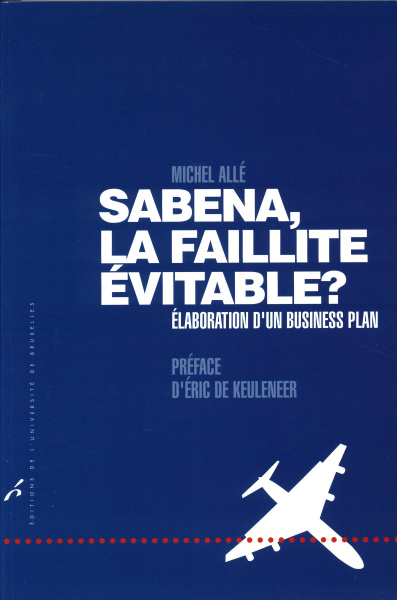Sabena, la faillite évitable ?
Élaboration d'un business plan
First Edition
Le 7 novembre 2001, la Sabena, la plus ancienne compagnie aérienne européenne après la KLM, était mise en faillite. Read More
Le 17 novembre 1997, moins de 4 ans avant la mise en faillite de la compagnie aérienne belge, le Conseil d'administration avait pris la décision la plus ambitieuse de l'histoire de la société en décidant d'acquérir 34 Airbus moyen-courriers de la famille A320 et d'amplifier le développement de la flotte long-courrier. Au total, les engagements pris ce jour-là représentaient 1,5 milliard d'euros, soit près de dix fois les fonds propres.
Quel fut le poids de cette décision sur la suite de l'histoire ? Était-elle basée sur de sains principes de gestion ? Quelles en étaient la logique et les conséquences ? A-t-elle rendu la faillite inévitable ?
En utilisant l'outil essentiel de la gestion moderne d'entreprise qu'est le business plan, l'ouvrage s'efforce de répondre à ces questions. Comme l'écrit Éric De Keuleneer dans sa préface, l'analyse d'un échec est toujours riche d'enseignements.
Le lecteur n'y trouvera cependant ni sensationnalisme ni mises en cause personnelles. Le propos est, en effet, d'expliquer pour progresser et non d'accuser pour régresser. Et surtout de faire comprendre à tous ceux qui veulent mieux appréhender la dynamique des entreprises, et en particulier aux étudiants, comment construire un business plan, comment l'utiliser et comment les principes et enseignements de la micro-économie peuvent servir de guide à une saine gestion.
Specifications
- Publisher
- Éditions de l'Université de Bruxelles
- Author
- Michel Allé,
- Preface by
- Éric De Keuleneer,
- Language
- French
- Publisher Category
- Publishers own classification > Business & Economics
- BISAC Subject Heading
- BUS000000 BUSINESS & ECONOMICS
- Onix Audience Codes
- 06 Professional and scholarly
- CLIL (Version 2013-2019)
- 3305 SCIENCES ECONOMIQUES
- Subject Scheme Identifier Code
- Thema subject category: Economics
Paperback
- Publication Date
- 16 February 2004
- ISBN-13
- 978-2-8004-1329-7
- Extent
- Main content page count : 212
- Code
- 1329
- Dimensions
- 160 x 240 x 14 cm
- Weight
- 427 grams
- ONIX XML
- Version 2.1, Version 3
Google Book Preview
Contents
- Préface | Éric DE KEULENEER
- Remerciements
- Introduction
- Chapitre I – La dynamique du transport aérien à la fin du XXe siècle
- Une industrie intensive
Une industrie cyclique et saisonnière
Les frais fixes d'un produit périssable
Dérégulation et libéralisation
Une industrie parmi les moins rentables
Le modèle « low cost »
Conclusions
Pistes de réflexion
- Chapitre II – Les forces et les faiblesses de la Sabena en 1997
- Les forces
Les faiblesses
Les opportunités
Les menaces
Conclusions
Pistes de réflexion
- Chapitre III – Enjeux et vision
- Boeing ou Airbus ?
Quel positionnement pour la Sabena ?
Quel réseau pour la Sabena ?
Conclusions
Pistes de réflexion
- Chapitre IV – Méthodologie
- La déclinaison de la stratégie
Les ressources nécessaires
Le travail chiffré
Communiquer pour décider
Conclusions
Pistes de réflexion
- Chapitre V – Les modes de financement de la flotte
- Achat ou location ?
Que prendre en compte ?
Conclusions
Exercice de comptabilité et d’analyse financière
Pistes de réflexion
- Chapitre VI – Les scénarios des étudiants
- Les hypothèses communes
Le scénario de l’ambition
Le scénario de la raison
Le scénario de la prudence
Le scénario Boeing
La traduction commerciale des scénarios
Des scénarios financièrement viables ?
Conclusions
Pistes de réflexion
- Chapitre VII – Hunter ou la décision du 17 novembre 1997
- Une stratégie de croissance forte
Des ambitions opérationnelles réalistes ?
Les conséquences financières
Conclusions
Pistes de réflexion
- Chapitre VIII – Virgin et City Bird, les gouttes d’eau ?
- Les similitudes et les différences
La goutte d’eau ou l’effet marginal
L’erreur corrigée : Magritte
Conclusions
Pistes de réflexion
- Chapitre IX – Études de sensibilité
- Une nouvelle guerre du Golfe
Les résultats financiers
Un nouveau choc pétrolier
Les convergences favorables
Conclusions
Pistes de réflexion
- Chapitre X – Le recours aux actionnaires et la création de valeur ?
- La logique des actionnaires
Les perspectives de création de valeur
Augmenter le capital ?
Conclusions
Pistes de réflexion
- Conclusion – « Time Flies »
- Connais ton environnement car il est concurrentiel
Connais-toi toi-même : l’entreprise a des faiblesses
Conçois et énonce clairement ta stratégie
Traduit cette stratégie en un plan opérationnel
Veille au financement de ton plan
Mesure tes risques
Valide tes certitudes auprès d’autres
Assure-toi de la cohérence de la mise en œuvre
Epilogue et émotions
- Annexes
- Annexe 1 – Structures de coût types (court-moyen-courrier et long-courrier)
Annexe 2 – Business plan – Exemple de données opérationnelles synthétiques et détaillées
Annexe 3 – Sabena – Données opérationnelles et compte de pertes et profits
1994-1997 – Bilan à la fin de l’année 1997
Annexe 4 – Le scénario de l’ambition
Annexe 5 – Le scénario de la raison
Annexe 6 – Le scénario de la prudence
Annexe 7 – Le scénario Boeing
Annexe 8 – Ambition – Taux de couverture des dépenses par les recettes
Annexe 9 – Hunter – Taux de couverture des dépenses par les recettes
- Liste des tableaux
- Liste des graphiques
- Bibliographie
- Terminologie

